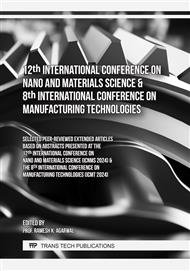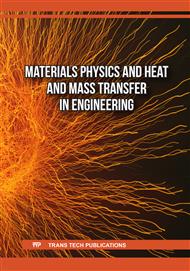[1]
A.N. Bogolyubov, I.A. Butkarev, D.V. Minaev and I.E. Mogilevskii, I. E: Mathematical simulation of guiding structures using the finite-difference and finite-element methods, in: Journal of Communications Technology and Electronics. Vol. 50.2 (2005), pp.128-137.
Google Scholar
[2]
P. Cardiff and I. Demirdžić: Thirty years of the finite volume method for solid mechanics, in: Archives of Computational Methods in Engineering. Vol. 28.5 (2021), pp.3721-3780.
DOI: 10.1007/s11831-020-09523-0
Google Scholar
[3]
H. Kai, B. Hongbai, L. Chunhong and C. Fengli: Sumarization on meshfree method and its application in metal forming, in: Forging Stamping Technology. Vol. 2 (2016), pp.12-17.
Google Scholar
[4]
H. Hussain, P.S. Tamizharasan and C.S. Rahul: Design possibilities and challenges of DNN models: a review on the perspective of end devices, in: Artificial Intelligence Review. (2022), pp.1-59.
DOI: 10.1007/s10462-022-10138-z
Google Scholar
[5]
A.E. Ilesanmi and T.O. Ilesanmi: Methods for image denoising using convolutional neural network: a review, in: Complex & Intelligent Systems. Vol. 7.5 (2021), pp.2179-2198.
DOI: 10.1007/s40747-021-00428-4
Google Scholar
[6]
G.R. Yang and M. Molano-Mazón: Towards the next generation of recurrent network models for cognitive neuroscience, in: Current opinion in neurobiology. Vol. 70 (2021), pp.182-192.
DOI: 10.1016/j.conb.2021.10.015
Google Scholar
[7]
R.A. Khalil, E. Jones, M.I. Babar, T. Jan, M.H. Zafar and T. Alhussain: Speech emotion recognition using deep learning techniques: A review, in: IEEE Access. Vol. 7 (2019), pp.117327-117345.
DOI: 10.1109/access.2019.2936124
Google Scholar
[8]
X.Y. Zhang, F. Yin, Y.M. Zhang, C.L. Liu and Y. Bengio: Drawing and recognizing chinese characters with recurrent neural network, in: IEEE transactions on pattern analysis and machine intelligence. Vol. 40.4 (2017), pp.849-862.
DOI: 10.1109/tpami.2017.2695539
Google Scholar
[9]
Y. Zheng, G. Li and Y. Li: Survey of application of deep learning in image recognition, in: Computer Engineering and Applications. Vol. 55.12 (2019), pp.20-36.
Google Scholar
[10]
Ö. Keleṣ, Y. He and B. Sirkeci-Mergen: Prediction of elastic stresses in porous materials using fully convolutional networks, in: Scripta Materialia. Vol. 197 (2021), p.113805.
DOI: 10.1016/j.scriptamat.2021.113805
Google Scholar
[11]
A. Hemmasian, F. Ogoke, P. Akbari, J. Malen, J. Beuth and A.B. Farimani: Surrogate Modeling of Melt Pool Thermal Field using Deep Learning, in: arXiv:2207.12259 (2022).
DOI: 10.2139/ssrn.4190835
Google Scholar
[12]
B. Liu, J. Kang, H. Zhao: Study on macro and micro modeling on solidification process of shaped casting. Chinese journal of mechanical engineering Vol. 15(2002.), pp.252-256.
DOI: 10.3901/cjme.2002.03.252
Google Scholar
[13]
S.Y. Lee, B.A. Tama, C. Choi, J.Y. Hwang, J. Bang and S. Lee: Spatial and sequential deep learning approach for predicting temperature distribution in a steel-making continuous casting process, in: IEEE Access. Vol. 8 (2020), pp.21953-21965.
DOI: 10.1109/access.2020.2969498
Google Scholar
[14]
O. Ronneberger, P. Fischer and T. Brox: U-Net: Convolutional networks for biomedical image segmentation, in: Medical Image Computing and Computer-Assisted Intervention–MICCAI 2015: 18th International Conference, Munich, Germany, October 5-9, 2015, Proceedings, Part III 18. Springer International Publishing. (2015), pp.234-24
DOI: 10.1007/978-3-319-24574-4_28
Google Scholar



